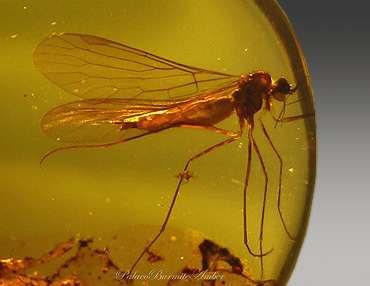
Scorpionfly in Prehistoric Amber
Myanmar (Burma)
Mid-Cretaceous Period – ~100 MYA
Amber is really old tree sap. It mainly comes from conifer trees, such as firs and pines that grew during prehistoric times. Once the sap falls, it’s eventually covered with soil and rock. Over eons, the pressure and heat surrounding the resin leaches out the soft residue, leaving behind a hard material which we call amber. Within amber may be found insects and other material from the era.
Amber can be found all over the world. However, the most plentiful is Baltic amber from Russia. This amber dates to around 44 million years ago. A rarer amber is from Myanmar and is known as Burmese amber or Burmite. This material dates well in to the era of dinosaurs, around 100 million years ago. The museum’s amber specimen is of this type.
The insect within the museum’s exhibit is called a ‘Long-Tongued Scorpionfly’. It’s formal genus species is Mecoptera Parapolycentropus, and belongs to the Pseudopolycentropodidae Family. Though very small, this insect was the key ancestor of the butterfly and moth, according to research.
This specimen was purchased for the museum in 2019 from Paleo Burmite Amber of Chiang Mai, Thailand. The dimensions of this piece are 23mm x 13.7mm x 3.5 mm and weighs 0.65 gms. The size of the Scorpionfly’s head and body is approximately 3.5mm.